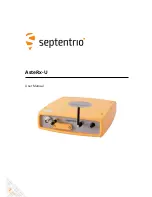
UBX-G7020 - Hardware Integration Manual
Design-in
GPS.G7-HW-10003
Objective Specification
Page 34 of 74
2.6.1.2
Out-of-band interference
Out-of-band interference is caused by signal f
requencies that are different from the GPS/GNSS carrier (see
The main sources are wireless communication systems such as GSM, CDMA, WCDMA, WiFi, BT, etc.
0
500
1000
1500
2000
GPS input filter
characteristics
0
-110
0
500
1500
2000
Frequency [MHz]
GSM
900
GSM
1800
GSM
1900
Power [dBm]
GPS input filter
characteristics
GPS
1575
0
-110
GPS
signals
GSM
950
Figure 16: Out-band interference signals
Measures against out-of-band interference include maintaining a good grounding concept in the design and
adding a GPS/GNSS band-pass filter into the antenna input line to the receiver.
For GSM applications like a typical handset design an isolation of approximately 20 dB can be reached with
careful placement of the antennas. If this is insufficient, an additional input filter is required on the GPS/GNSS
receiver input to block the remaining GSM transmitter energy.
2.6.2
RF front-end circuit options
The first stages of the signal processing chain are crucial to the overall receiver performance. Also, in many
applications an input connector may be used to receive the RF-input. This can provide a conduction path for
harmful or even destructive electrical signals and hence the RF input needs to be protected accordingly.
The following points should be considered seriously in order to determine the appropriate RF-input circuitry:
1.
Is the design used to receive GPS only or is it intended to design a combined GPS/GLONASS receiver?
a.
In the latter case special attention has to be taken to the RF band-pass filter (F1). Because
GLONASS is received at 1602 MHz instead of 1575.42 MHz for GPS, the filter bandwidth has to
be increased (see recommended parts in section 3.5).
b.
If an additional LNA protection filter (F2) shall be used its bandwidth has also to be increased
(see recommended parts in section 3.6).
2.
What is the expected quality of the signal source (antenna)?
a.
If an external active antenna is to be used, what signal power will be delivered?
b.
If a passive antenna is being used, how susceptible is it to load matching? What is the antenna
gain & directivity?
3.
Are destructive RF power levels expected to reach the RF-input? Check against the maximum ratings
provided in the
UBX-G7020-Kx Data Sheet
[1] and
4.
Is interference from wireless transmitters expected?
a.
What are the characteristics of these signals (duty cycle, frequency range, power range, spectral
purity)?
b.
What is the expected GPS/GNSS performance under interference conditions?
5.
Is there a risk of RF-input exposure to excessive ESD stress?
a.
PCB / system assembly: Is there risk that statically charged parts (e.g. patch antennas) may be
discharged through the RF-input?
Confidential















































